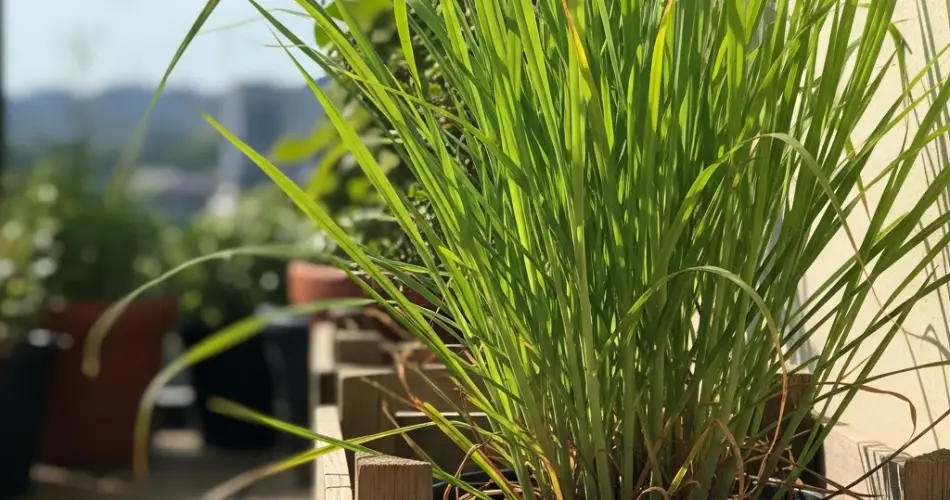Lemongrass (Cymbopogon citratus) is a fragrant and versatile herb widely used in cooking, teas, and herbal remedies. Its fresh, citrusy flavor enhances soups, curries, stir-fries, and beverages, while its tall, elegant foliage adds visual appeal to any space. For urban gardeners or those with limited outdoor areas, growing lemongrass in balcony crates is an efficient and sustainable way to enjoy fresh herbs year-round.
Crate gardening allows you to cultivate lemongrass in a compact space while maintaining control over soil quality, water, and sunlight. Wooden or plastic crates provide lightweight, mobile containers that are easy to manage, making them ideal for balconies, patios, or rooftop terraces.
Selecting Crates and Preparing the Balcony
Choose a sturdy crate capable of holding soil, water, and mature lemongrass clumps. Wooden crates provide breathability and a natural look, while plastic crates are durable and easy to clean. Ensure the crate has adequate drainage by drilling holes in the bottom to prevent water accumulation, which can harm the roots.
Place the crate in a sunny location, as lemongrass thrives with at least 6 hours of direct sunlight daily. South- or west-facing balconies are ideal. Elevating the crate slightly on a plant stand improves air circulation and makes harvesting more convenient.
Preparing Soil for Lemongrass
Lemongrass grows best in fertile, well-draining soil. A high-quality potting mix enriched with compost or organic fertilizer provides essential nutrients. Avoid dense garden soil that can compact in crates and hinder root development.
For optimal drainage, add a thin layer of gravel or small stones at the bottom of the crate. Fill the remainder with potting mix, leaving a small gap at the top to allow for watering and mulching. Proper soil preparation ensures healthy, tall stalks and vibrant, aromatic leaves.
Planting Lemongrass in Crates
Lemongrass can be grown from fresh stalks, divisions, or small nursery plants:
-
From stalks: Choose fresh stalks with firm white bases. Place the bases in water until roots form, typically within 1–2 weeks, then transplant them into the crate.
-
From divisions: Separate healthy clumps from an existing plant and plant them 20–25 cm apart to allow for growth and airflow.
Firm the soil around the roots and water thoroughly to help the plants establish quickly. Proper spacing encourages strong stalk development and dense foliage.
Watering and Maintenance
Lemongrass prefers consistently moist soil but does not tolerate waterlogged conditions. Water when the top 2–3 cm of soil feels dry, making sure excess water drains freely. Crates can dry faster than ground containers, so monitor moisture levels regularly, especially in warm weather.
Mulching the soil surface helps retain moisture, regulate temperature, and suppress weeds. Occasional misting supports humidity and lush leaf growth, but avoid wetting foliage excessively to prevent fungal issues.
Sunlight Requirements
Full sun is essential for strong growth. Lemongrass requires at least 6–8 hours of direct sunlight daily. If your balcony receives limited natural light, consider using supplemental grow lights to maintain sturdy stalks and vibrant flavor. Adequate sunlight ensures thick, aromatic leaves and prevents spindly growth.
Fertilizing Your Crate Lemongrass
Container-grown lemongrass benefits from regular feeding, as nutrients in small soil volumes are used quickly. Apply a balanced liquid fertilizer every 3–4 weeks, or incorporate a slow-release organic fertilizer into the soil at planting.
Organic fertilizers like compost tea or fish emulsion encourage healthy growth and enhance flavor. Avoid excessive nitrogen, which can encourage leafy growth at the expense of thick stalks.
Harvesting Lemongrass
Lemongrass is ready to harvest when stalks reach 30–45 cm in height and have firm bases. Cut stalks near the soil level, leaving the roots to regrow. Trim leaves as needed for cooking, teas, or garnishing. Frequent harvesting promotes bushier plants and ensures a continuous supply of fresh lemongrass.
Freshly harvested stalks can be used immediately or stored in the refrigerator for up to two weeks.
Tips for a Thriving Balcony Lemongrass Garden
-
Rotate crates occasionally for even sunlight exposure.
-
Remove yellow or damaged leaves to maintain plant health.
-
Monitor for pests, such as aphids or spider mites, and treat with natural methods if necessary.
-
Ensure the crate is stable and securely positioned to prevent accidents.
Final Thoughts
A balcony lemongrass crate garden is a practical, sustainable way to grow fresh, aromatic herbs year-round. This approach maximizes limited space, allows precise control over growing conditions, and keeps flavorful stalks within easy reach.
With proper soil preparation, consistent watering, adequate sunlight, and regular harvesting, your balcony lemongrass garden will thrive. This method transforms a simple balcony into a productive, fragrant, and visually appealing herb garden, providing fresh lemongrass at your fingertips all year long.



